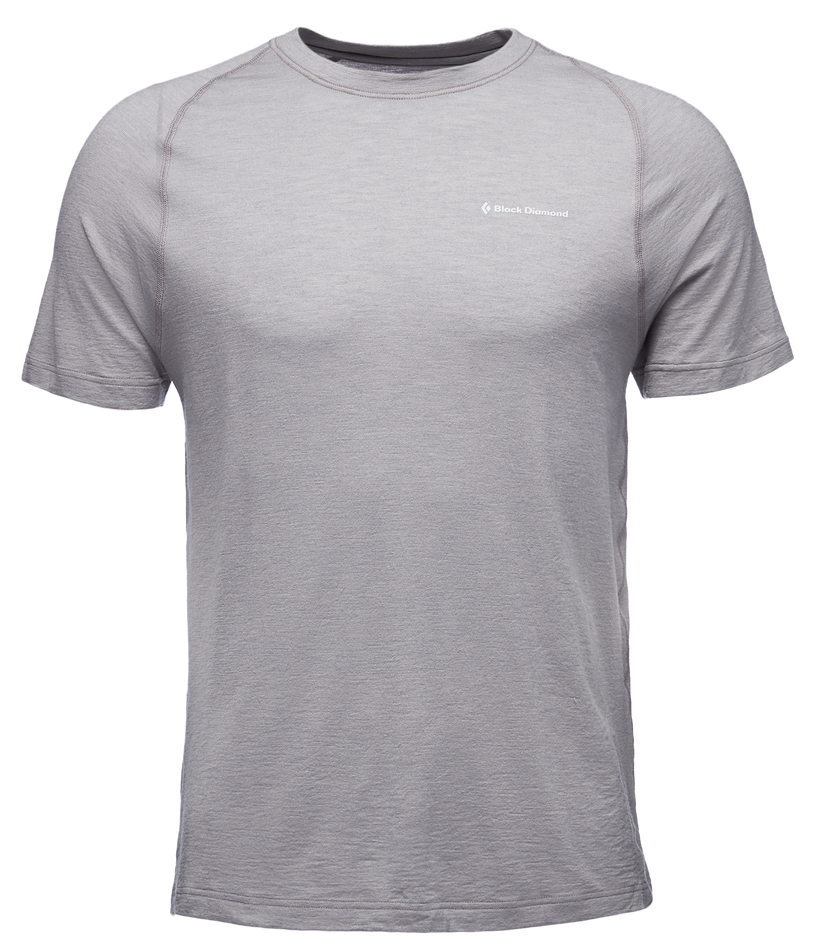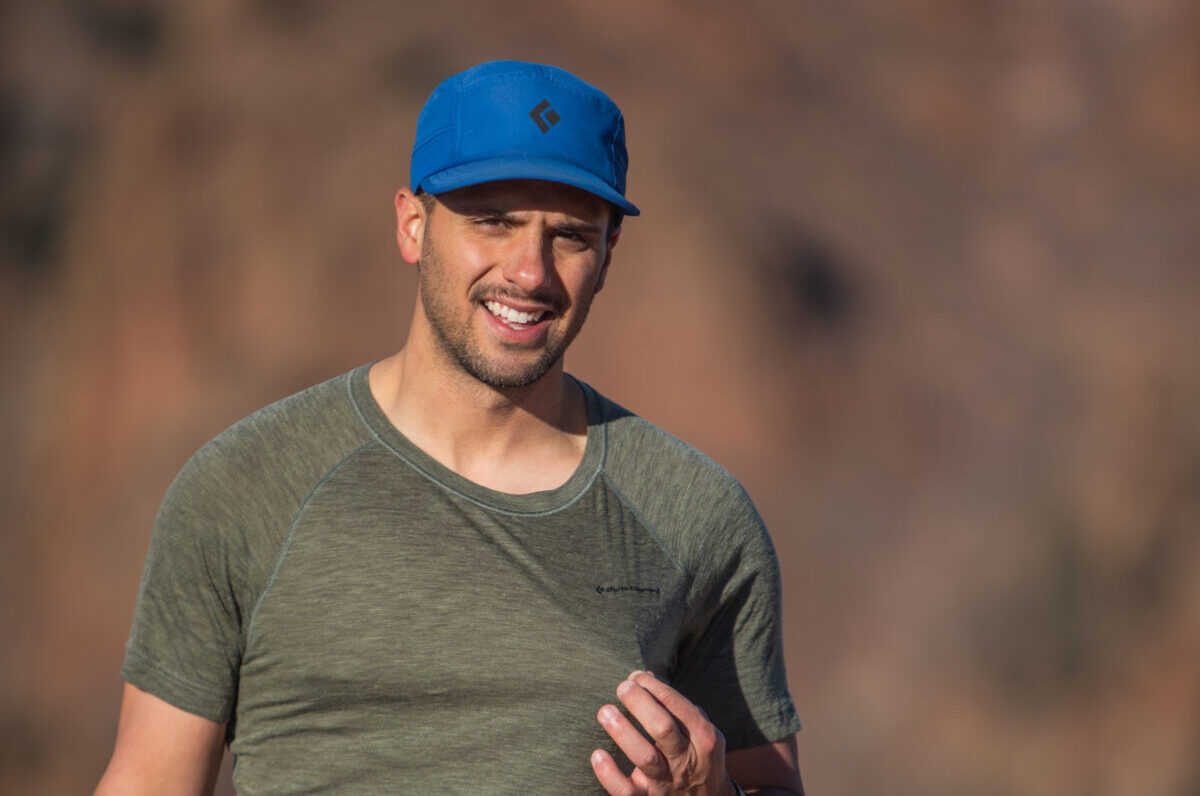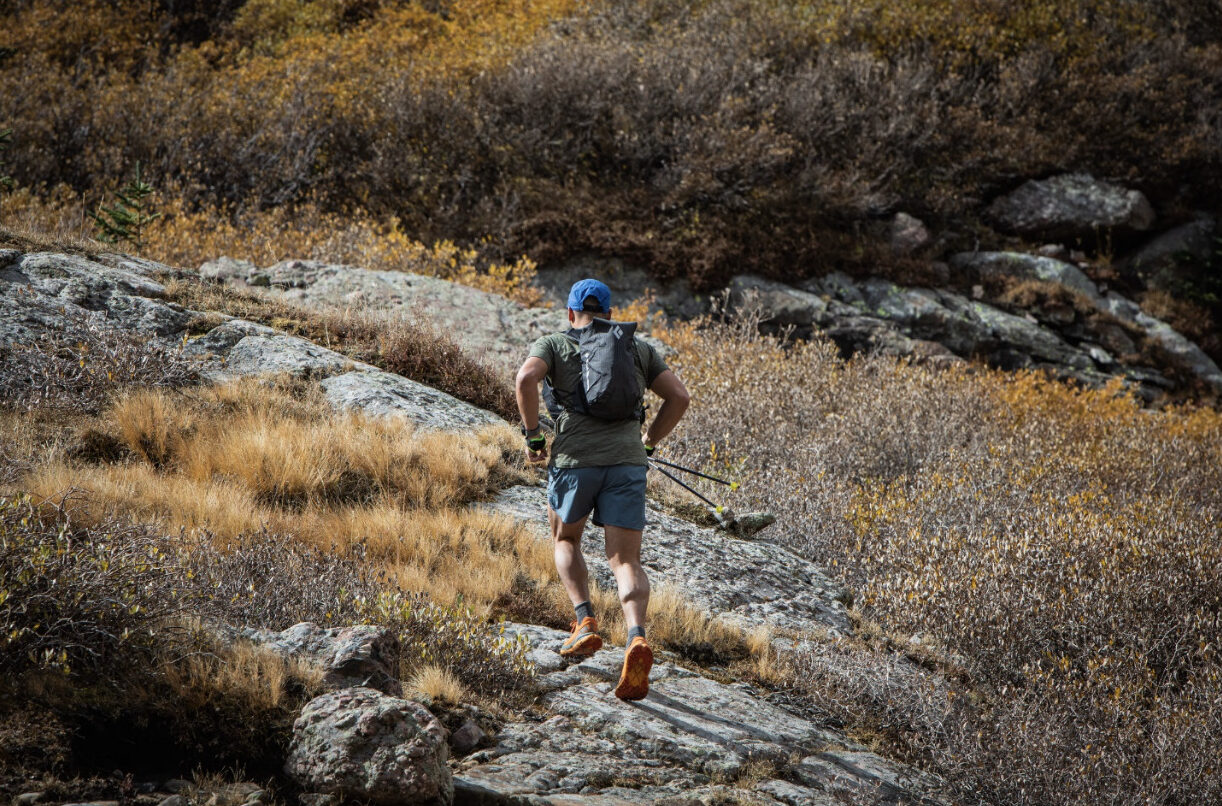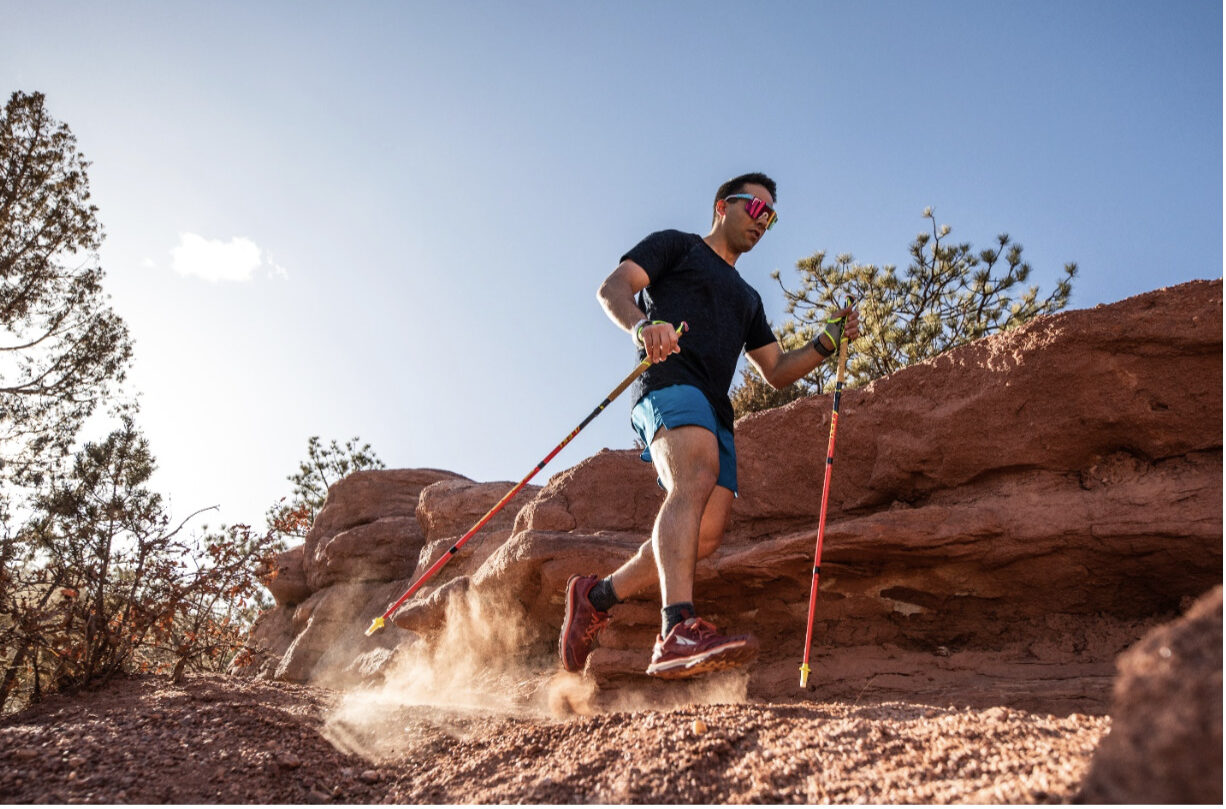Black Diamond Rhythm T
Test Duration: 2000+ miles
Test Locations: Monument, Colorado Springs, & Sangre De Cristo Mountains, Colorado
Fabric: NuYarn 95 gsm jersey (57% nylon / 43% Merino wool)
Stated Features:
- Allegedly dries 5 times faster than standard Merino wool
- Reportedly 35% more stretch than standard Merino wool
Stated Weight: 95 grams (Men’s) / 69 grams (Women’s)
Blister’s Measured Weight: 95 g (US Men’s Size M)
MSRP: $90
Size Tested: US Men’s M / EU 46-48
Reviewer: 5’6”, 140 lbs / 168 cm, 63.5 kg

Intro
With roots going as far back as the 1950’s, Black Diamond Equipment was originally the thought experiment of Yvon Chouinard, known as Chouinard Equipment Ltd. The brand got its start with Yvon selling hand-forged pitons out of the trunk of his car in the Yosemite Valley in the 1960’s. When the brand fell upon hard financial times in the late 1980s, it was purchased by a group of employees who changed the company’s name to Black Diamond. 30 years and a few financial buyouts later, Black Diamond continues to be a major player in the outdoor industry.
Black Diamond makes gear for all sorts of mountain athletes, focusing on products for everything from climbing and skiing to hiking and trail running. In 2019 they introduced their Distance Line, a collection designed specifically with mountain runners in mind. Ranging from fastpacking gear to running apparel, the Distance Line is meant to endure tough alpine conditions.

Fit
For context, I’m about 5’6” / 140 lbs (168 cm, 63.5 kg), and as a vertically challenged yet muscular runner, I’ve always had a difficult time finding running shirts that fit me properly. I’m not a fan of super tight-fitting shirts or those that are too baggy, and I don’t like shirts that are so long that they fall to my hips or hug my shoulders. This might not seem like a giant ask, but I have been searching for the holy grail of running T-shirts for what feels like forever. One day while scrolling through Instagram after returning my 5th different shirt that didn’t fit correctly, I came across a Black Diamond video of Joe Grant descending a scree field off of Mount Yale wearing the newly released Rhythm T. Joe’s a running idol of mine, so I decided to give his shirt a shot.
The Rhythm T’s fit lines up with how Black Diamond characterizes it, specifically as a slimmer fitting tee that’s designed to be form fitting yet not too snug. Don’t be discouraged by the concept of the “slim taper,” as the shirt never gave me the impression of a slim fitting shirt, but rather an “athletic fit.” By “athletic fit” I mean that the Rhythm T left me feeling free, but it wasn’t too baggy, and certainly not constricting. On a range between the constricting feel of a tight Under Armour base layer on one end and a baggier Smartwool Merino Sport T on the other, the Rhythm T sits right about in the middle. Length-wise, I found that a Men’s Medium suited me perfectly, though I am on the shorter side, so this abridged hem length could be an issue for taller folks. With that said, the shirt’s shorter hem did cause it to ride up my back a bit when wearing a running pack, which led to inevitable chafing just above my waist. I don’t want to blame the Rhythm T’s cut entirely for this, but it’s something to keep in mind if you routinely run with a pack / vest.

I have tried several other Black Diamond shirts in a Men’s Medium, including the Lightwire Tech T & the Flux Merino T, the latter of which I thought would be extremely similar to the Rhythm T. However, that didn’t end up being the case, as neither of those two shirts had the same fit to the Rhythm T. In my experience, the Lightwire T is boxier and less form fitting while the Flux Merino T has a much longer hem.
Another note about sizing: I found a lack of consistency in the Rhythm T’s fit across the different colors it’s available in. For instance, the black shirt stood out as feeling a bit tighter compared to the looser fitting pewter and olive colors. I don’t believe this was a one-off issue, either, as I tried on two, sometimes three of each shirt in each color. The variance was small yet still noticeable, so for someone looking for a slimmer fit, it might be worth trying on the Rhythm T in black first.
Construction
I can recall a scene from an episode of Mad Men where Don Draper asks for a drink to be made “simple, yet significant.” To me, the Rhythm T is exactly that. From the second I put it on I could tell it was designed with a runner in mind. Constructed from a blend of merino wool and nylon, the shirt is both light and stretchy. Black Diamond uses NuYarn wool for this piece, which they dub “the world’s first performance wool,” a material that’s allegedly lighter, stretchier, more breathable, faster drying, and retains more heat than traditional merino. This is the result of NuYarn’s unique yarn construction process — they keep the details a little close to the chest, but NuYarn is neither core-spun nor ring-spun like pretty much all other merino / synthetic yarns.
In my experience, these claims all held water when I tested the Rhythm T against its competitors (and our other reviewers who have used other NuYarn pieces agree). In my opinion, the construction of the shirt is its main value proposition, and one that I think is well worth its $90 price tag, though that’s obviously pretty pricey for a T-shirt.
Weight
According to both Black Diamond’s scale and my own, a Men’s Medium in the Rhythm T weighs 95 grams, which is about average in the context of running shirts. I live on the Front Range of Colorado and we get fairly mild weather, so this shirt’s neutral weight complemented that well. If you’re looking to go light and fast in the spring and summer, the Rhythm T is a great option; for the fall and winter, it can serve as a pretty solid base layer that’ll do a good job of wicking sweat. I’ve listed the stated weights of several other popular running shirts below for comparison, and while the Rhythm T isn’t the lightest overall, it does have the lowest weight out of any shirt using merino wool.
Janji Helio T – 72 g / 2.54 oz
Hoka Glide T – 74 g / 2.6 oz
The NorthFace Flight Weightless T – 88 g / 3.1 oz
Black Diamond Equipment Rhythm T – 95 g / 3.4 oz
Patagonia Capilene Cool Daily T – 105 g / 3.7 oz
Black Diamond Equipment Lightwire Tech T – 108 g / 3.8 oz
Smartwool Men’s Merino Ultralite T – 110 g / 3.9 oz
Arc’teryx Cormac Crew T – 110 g / 3.9 oz
Black Diamond Equipment – Flux Merino T – 123 g / 4.3 oz
Smartwool Merino Sport 150 Tech T – 132 g / 4.6 oz
Nathan Rise T – 133 g / 4.7 oz
Durability
Black Diamond billed the Rhythm T as nearly 50% stronger than other shirts in its category. How they define “durability” is quite subjective. I tend to break that metric into two categories: how well the shirt stays together after trips through the wash and how well it holds up on trail.

I now own about eight Rhythm Ts and have never run into any issues with machine washing them — no frayed seams and no discoloration to speak of. My girlfriend is often quite vocal about when I get behind on my laundry, so these shirts are washed quite often. That said, I do hang dry them, which I think is smart to do with most running apparel anyway.
[Editor’s Note: Our managing editor, Luke Koppa, has put a few hundred days in various NuYarn pieces, and he’s lazy so he just tumble dries them on low heat. The result has been maybe ⅓ of a size worth of shrinkage, and likely a reduction in long-term durability, but they’ve all still lasted hundreds of days.]
In terms of basic durability on the trails and on the roads, I would give this shirt a high rating. I experienced very little wear and tear in normal training, so I expect these shirts to last quite a while if used mainly in that context. On more technical terrain, the Rhythm T has held up against my various tumbles down scree fields, which surprised me. That said, I have managed to tear two of mine on tree branches, which is quickly becoming their kryptonite (and that of most merino shirts). Fortunately, Black Diamond offers a 1-year warranty on all soft goods and apparel, so exchanging my injured Rhythm T for a fresh one was no problem.
On Trail
Over the course of 2,134 miles and counting, to say I tested the Rhythm T in just about every condition would be pretty accurate. From racing to FKTs to daily training, and from Colorado 14ers to humid South Florida beaches, this shirt has accompanied me on a kaleidoscope of adventures. This shirt really has do-it-all ability. As someone who races competitively, I tend to train in the exact same gear that I’ll use on race day to avoid surprises. Below, I’ll break down the Rhythm T’s performance in several different scenarios to highlight its versatility.

Racing – my racing season typically spans from late spring to early fall, so definitely a warmer time of year. I specialize in sub-ultra mountain running and like to race light, so I look for apparel that’s durable, breathable, extremely light, and will keep me warm for early race starts but won’t cause me to overheat later in the day. This past year, I wore the Rhythm T during the Sangre De Cristo Ultras 14K, which had temps ranging from 30°F (-1°C) at race start to 60°F (15°C) once the sun came up. The Rhythm T’s fabric did a great job of keeping my core warm at the start and controlling my temperature as I started to sweat. I couldn’t have been more thrilled with the way it performed.
FKTs – I tend to plan most of my FKT attempts in the fall when my racing tapers off. They usually take place in the Colorado alpine, where temperatures are significantly colder and the terrain is much more technical than where I live on the Front Range. A great example of when the Rhythm T shined was during a recent FKT I lined up with some friends in the Sangre De Cristo mountains this past October. Due to how technical the route was and the frigid alpine conditions that time of year, we knew this outing would be slower going than our normal runs, so we dressed accordingly. I used a long-sleeved version of the Rhythm T as my base layer and it did a phenomenal job of keeping me warm by wicking sweat so I stayed mostly dry.
Training – This setting is where I spent the most time in the Rhythm T. Simply put, I took it everywhere with me. This shirt handled just about everything I threw at it, aside from a few tree branches. As an extremely picky and detail-oriented person, I was really happy to have found a shirt that proved to be reliable in so many different conditions. I had very few complaints in the time I spent testing it — the fit worked well for me, I found it to be plenty durable, it did not chafe (unless I was wearing a heavy pack), the temperature control was great, and if the day was extremely hot, the shirt was light and compressible enough that I could take it off and stuff it into my running belt.
Who’s It For?
For me, the Rhythm T has really been the Swiss-army knife of running shirts. While Black Diamond created this shirt as a durable option for technical mountain running, I think any and all runners can benefit from it. If casual efforts on the trail are your thing, the Rhythm T is a comfortable, breathable, and adaptable choice, and if you are one to push the limits, it should be tough enough to withstand long days above treeline.
Bottom Line
If this isn’t already obvious, I think Black Diamond blew the doors off the competition with the addition of the Rhythm T to their Distance Line. Very rarely do I review a piece of gear or apparel and hope the brand doesn’t make any changes to it; however, I feel like this might be one of those rare items where the best thing Black Diamond can do is keep their hands off of it. Overall, there isn’t another merino shirt I’ve used that can keep up with the Rhythm T, certainly in terms of weight, stretch, and overall comfort. While $90 is a lot to spend on a shirt, the Black Diamond Rhythm T will likely be a worthwhile addition to many runners’ wardrobes.

I have owned two of these for a few years and use them for a variety of activities. One thing not touched on here is the quite impressive anti-odor capabilities of this shirt. I’ve worn mine for up to 7 days of workouts/runs and it smells barely different from when it was fresh! The one downside I’ve noticed is it gets quite a bit saggy when wet.